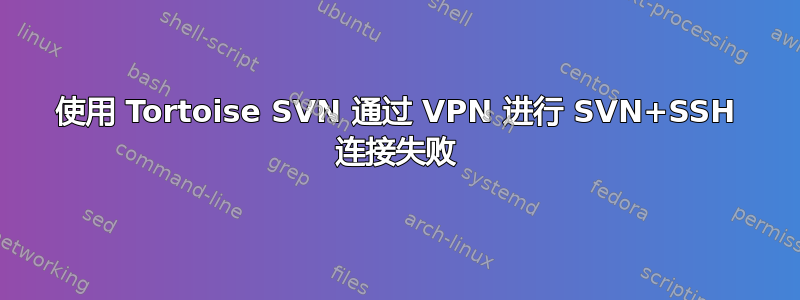
我正在使用运行 Windows 7 的 64 位系统。我安装了 Open VPN 和 Tortoise SVN 64 位。
存储库位于远程系统中,我们使用 VPN 连接。
我已按照必要步骤启动 VPN 连接 -
- 在 Open VPN 安装路径的配置文件夹中添加了一些项目特定的配置文件。
- 使用用户发起开放式 VPN 连接。
- 运行Putty的Pageant.exe并添加必要的密码。
到目前为止一切都很好。
然后我进入本地目录并尝试使用 Tortoise SVN 检出远程存储库 URL。但它抛出了以下错误 -
结帐失败
To better debug SSH connection problems, remove the -q option from 'ssh' in the [tunnels] section of your Subversion configuration file.
Network connection closed unexpectedly
以下是我的 Subversion 配置文件的 [tunnels] 部分的内容 -
### Section for configuring tunnel agents.
[tunnels]
### Configure svn protocol tunnel schemes here. By default, only
### the 'ssh' scheme is defined. You can define other schemes to
### be used with 'svn+scheme://hostname/path' URLs. A scheme
### definition is simply a command, optionally prefixed by an
### environment variable name which can override the command if it
### is defined. The command (or environment variable) may contain
### arguments, using standard shell quoting for arguments with
### spaces. The command will be invoked as:
### <command> <hostname> svnserve -t
### (If the URL includes a username, then the hostname will be
### passed to the tunnel agent as <user>@<hostname>.) If the
### built-in ssh scheme were not predefined, it could be defined
### as:
# ssh = $SVN_SSH ssh
### If you wanted to define a new 'rsh' scheme, to be used with
### 'svn+rsh:' URLs, you could do so as follows:
# rsh = rsh
### Or, if you wanted to specify a full path and arguments:
# rsh = /path/to/rsh -l myusername
### On Windows, if you are specifying a full path to a command,
### use a forward slash (/) or a paired backslash (\\) as the
### path separator. A single backslash will be treated as an
### escape for the following character.
这是错误中提到的部分吗?我-q在那里看不到任何选项。现在应该做什么。
答案1
取消注释该行:
\# ssh = $SVN_SSH ssh


